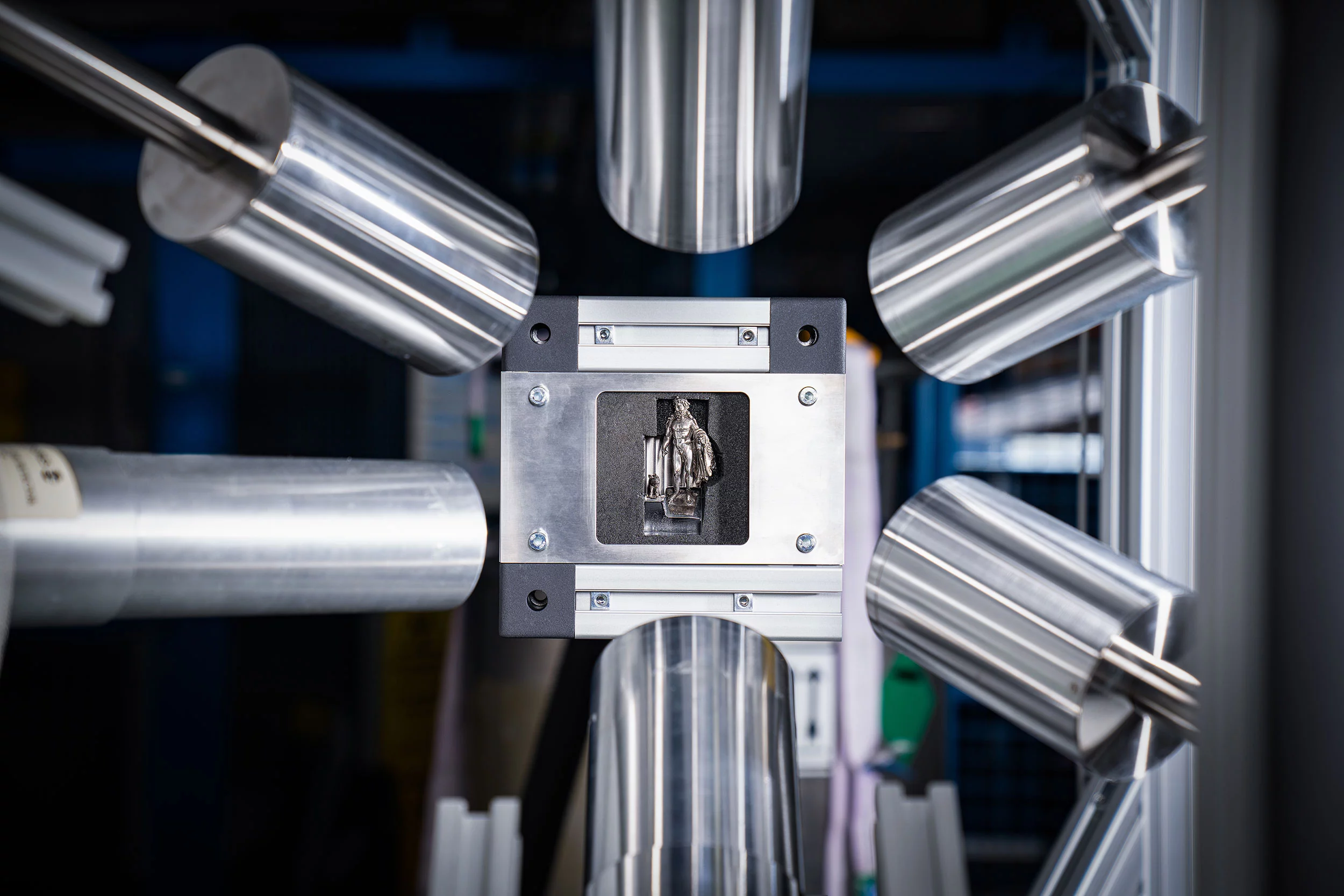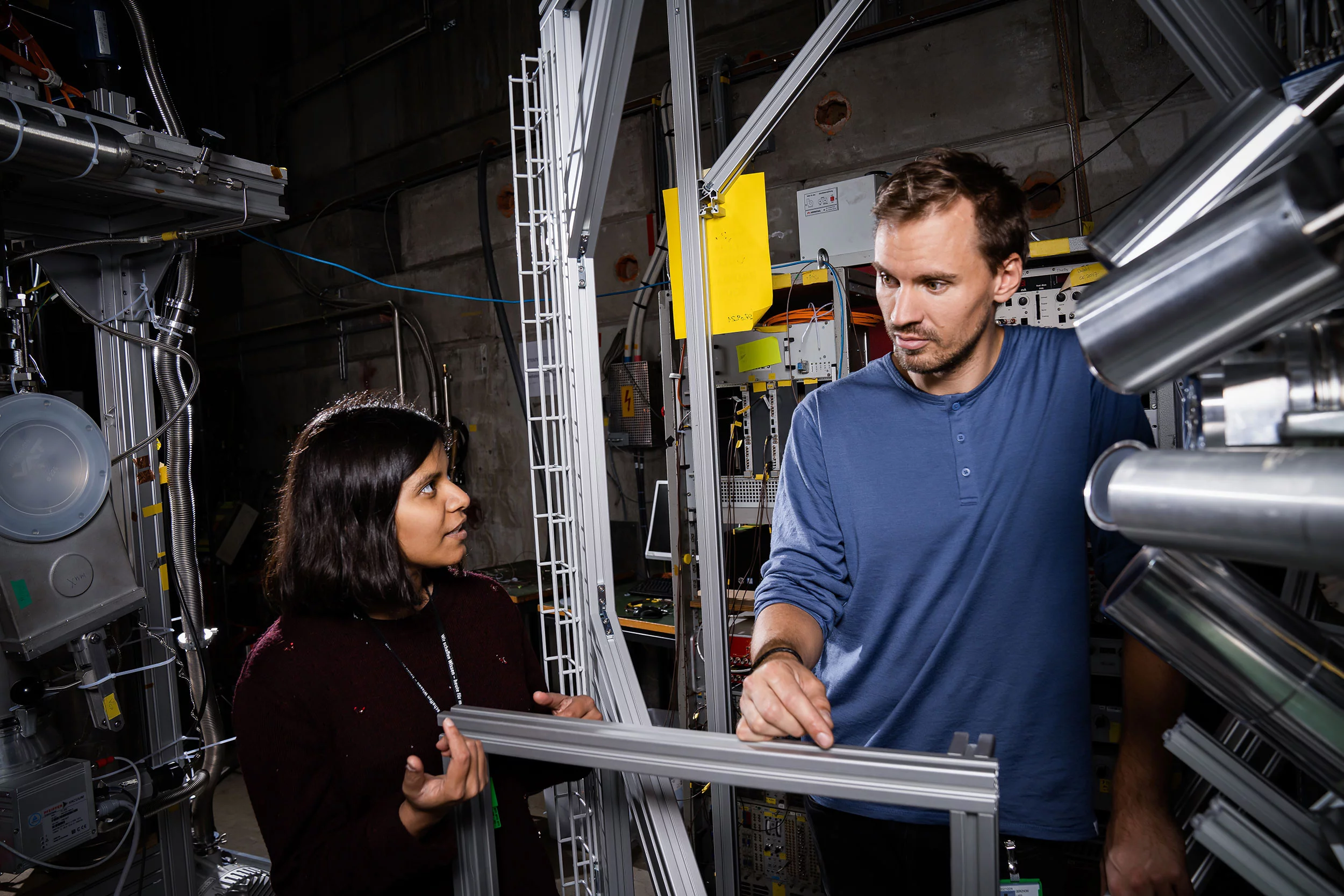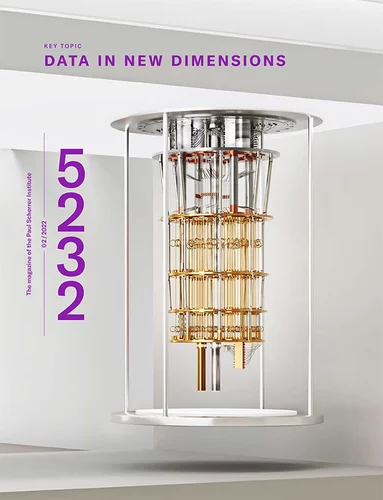For ancient artefacts and modern technologies alike, examination methods that leave the object completely intact are required. For this, researchers at PSI use elementary particles called muons and are developing a new experimental method that is useful for archaeology and can also answer questions relevant to battery development.
By hand, two researchers are putting the final touches on preparations to transport a measuring instrument. For security, the apparatus – developed and assembled by a research group at PSI over the past ten months – is framed by a set of rods roughly two and a half metres high. “This instrument will enable us to non-invasively determine the chemical composition of a sample,” explains Lars Gerchow, who was responsible for designing it. For this, the researchers will need special elementary particles called muons.
Gerchow, his colleague Sayani Biswas, and others lending a helping hand are in the large hall housing PSI’s muon source. Muons are naturally occurring elementary particles that are pervasive as part of cosmic radiation. “On average, a muon rains down on us every second,” the physicist explains. Nevertheless, at PSI these particles are generated artificially with the help of a large accelerator.
The measuring instrument is ready to be moved to its intended place – a delicate task that requires an indoor crane. The crane operator receives instructions from the ground by radio, and then the instrument is hoisted aloft.
Gold and silver from a Roman settlement
In the control room, from which the physicists will monitor the muon experiment, archaeologist Isabel Megatli is making the final preparations for her mission. She has brought precious gold and silver objects that were excavated in Augusta Raurica, one of the most important Roman sites in Switzerland, around ten kilometres east of Basel. Especially lovely are two figurines from the second century CE, representations of Roman deities from a household shrine. Hercules with a lion’s skin over his arm, just six centimetres tall, is accompanied by a mythological boar that the researchers have nicknamed “the little pig”. Minerva wears a richly pleated robe and an extravagant helmet.
The statuettes were cast from silver and partially gilded. “We want to know which silver alloy was used,” Megatli says. “With previous methods, we could only investigate the outermost hundredths of a millimetre, but often this surface has been adulterated over the course of centuries.” With muons, in contrast, it is possible to look inside several millimetres deep.
We were able to show that Minerva and Hercules are made of a high-quality silver alloy.
Megatli has also brought along several ancient pieces of jewellery that were found as grave goods. “The metal casters of antiquity all had their own strict recipes,” the archaeologist explains. “If two objects have the same alloy, it is also likely that they were made in the same workshop.” Through further examinations, the researchers can sometimes even determine which mine was the source of the metal ores used. “And we can also expose counterfeiters,” Megatli says, “as aluminium, for example, has only been processed since the 19th century.”
Fingerprint of the elements
Physicist Sayani Biswas explains how the experiment will work. “We have a sample, and we send negatively charged muons to it.” An atom in the sample captures a muon. Now, in place of an electron, a muon is orbiting the atom’s nucleus. At first it is in an excited state, and then it falls stepwise to its ground state. In the process, X-rays are emitted. The energy of this radiation is characteristic for the type of atom: in other words, the element that has captured the muon. Biswas, who is responsible for the data processing and analysis, points to a previously recorded curve that has sharp peaks, a socalled spectrum. Each element has a specific pattern of such lines in the spectrum – like a fingerprint.
In the hall, the measuring instrument has now been delivered with the utmost care to its destination. Several specialists are now attaching six large X-ray detectors to the rods.
Alex Amato, interim head of the Research with Neutrons and Muons Division at PSI, is also lending a hand. He initiated the project, which is a joint effort of PSI, the Roman settlement of Augusta Raurica, Empa, and the Natural History Museum of Bern, with financial support from the Swiss National Science Foundation, which is providing nearly one and a half million Swiss francs within the framework of the Sinergia Programme. “Thirty years ago, researchers at PSI were already trying to use muons to determine the elementary composition of materials deep inside, but at that time the particle beam was not sufficiently intense,” the research leader explains. “Today we’re twenty times better. And our instruments are a thousand times more powerful than our colleagues’ in the UK and Japan who are performing similar experiments.”
The Sinergia description also states: “This project aims to make Switzerland one of the leading locations worldwide in non-destructive element analysis.” And huge demand is expected from industry, culture, and academic fields.
But the researchers are still at the beginning – gathered in the control room before a row of computer monitors. Now there is no human activity in the experiment area, but only the statuettes of Hercules and Minerva, awaiting examination. They stand in foam holders cut to fit and placed in metal frames, which in turn have been positioned on a rail in front of the detectors. In the control room, Lars Gerchow gives the command: “We can start the beam.” With that, the measurements begin, and will continue around the clock.
Batteries in the muon beam
Two days later, the researchers place a completely different object in the muon beam: a lithium-ion battery. “We want to find out how the battery ages through use,” explains Ryo Asakura, a researcher at Empa in Dübendorf. For this he has brought both a new and a used battery to PSI – little flat packs that look like the batteries in smartphones. “The cathode of these batteries contains nickel, manganese, and cobalt,” Asakura explains. Over time, these metals shed from the cathode – which contributes to the ageing of this type of battery. The measurements with the muons should make this process visible. Later, the researchers would like to trace what happens to the lithium in the battery. The results should help to improve both the energy density and the safety of lithium-ion batteries.
After a week, the measurements on the ancient objects as well as the batteries have been completed. “With the battery, we see nice lines for nickel, manganese, and cobalt in the spectrum,” says Sayani Biswas with satisfaction. In the coming weeks, Ryo Asakura will repeatedly charge and discharge the batteries at Empa so that, during a second measurement period, the changes following this ageing process can be observed.
The spikes show two silver isotopes
In the measurement data on the samples from Augusta Raurica, Sayani Biswas points to several overlapping peaks: “Here you can see two different silver isotopes,” that is, minimally different types of silver atoms. The relationship between these isotopes can help archaeologist Isabel Megatli determine the origin of the silver. She is already enthusiastic about the preliminary results: “We were able to show that Minerva and Hercules are made of a high-quality silver alloy.”
The next measurement period is planned to start in two months. Then, besides other antique pieces and the lithium-ion batteries, a Bronze Age arrowhead that may have been made from meteorite material will be examined. “To answer this question, too, our non-destructive method is perfectly suited,” says Lars Gerchow.



